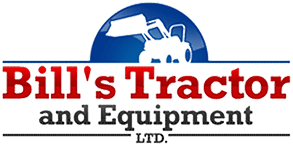Tractor Safety Tips
At Bill’s Tractor, we understand that tractors are an indispensable and integral part of your workflow and they can obviously also be quite dangerous. By implementing these tips and standard practices, you can lessen your risk of accidents or damage to your tractor. While these may seem self-evident, your life and the lives of others are at stake. A quick review of safety standards is always beneficial.
1. Prevent Dangerous Rollovers
Rollovers account for the majority of all tractor accidents annually in the US. These tips for avoiding a rollover can be used to stay safe and avoid an accident.
Avoid rollovers by avoiding steep hills or turning at excessive speeds.
Ensure that you don’t drive too closely to ditches or slopes.
Always keep the loader bucket low when moving.
Add weight to your tractor like water in the rear tires to help stabilize it.
Make sure your tractor is equipped with a rollover protection structure (ROPS) and a seatbelt; don’t operate a tractor that doesn't have these features.
2. Check Your Surroundings Constantly
Knowing your surroundings is an easy way to help avoid an accident when operating a tractor. These tips should help you to maintain a safe work environment that you are comfortable operating a tractor within.
Maintain a safe distance from people (especially children) when starting the
tractor or when changing attachments – shredders can throw rocks and debris
out, for example, so make sure no one is close by.
Never get close to any moving parts, implements or drive shafts when operating. The PTO Shaft as well as any rotating implements like tillers, balers, and post hold diggers can be very dangerous.
Look around you each time you turn or change direction and never swing or move a load with people around.
Be aware of power lines or other obstacles when the bucket is raised.
On the roadways, watch behind you as much as in front of you; always keep an eye out for other drivers not paying attention. Also, try to avoid traveling on roadways during peak traffic times and always mount a “slow-moving vehicle” sign (large red triangle) on the back of your tractor.
3. Daily Maintenance Routine
Set up a quick routine each time you operate your tractor and make sure to:
Check that attachments are secured properly.
Check engine oil and hydraulic fluid.
Check radiator coolant levels.
Check brakes and brake fluid.
Check tire pressure, guards, signals, lights and fan belts.
Get in the habit of running through this checklist every day or before each use.
4. Wear Appropriate Clothing
Loose clothing and long hair can easily get caught in any moving parts of your
tractor. Wear fitted pants or jeans, tuck in shirt tails, wear steel-toe boots or sturdy work
shoes. Heavy gloves and safety glasses may also be helpful when working on
your tractor or performing any maintenance.
5. Mount and Dismount Safely
Most tractor-related injuries occur from falls when mounting or dismounting. Make sure you consider the following when operating a tractor.
Make sure the machine is off and the parking brake is set.
Be sure to either keep one foot and two hands or two feet and one hand on the
tractor at all times while climbing in or out.
Be sure pant cuffs, boot or shirt loops, shirt sleeves, etc. are not caught on any pedals or gear shifter knobs before dismounting.
Be especially careful that your clothing doesn’t get hung up on the shifter as you’re dismounting as this can cause the tractor to go into gear if the engine is still running and start moving with no one in control, increasing the risk of an accident occurring.
6. Additional Precautions While Operating Your Tractor
Don’t ever stand or work under a lifted bucket or lifted attachment without protective support. People have been killed by unexpected hydraulic failure.
Use the loader only for the purposes intended, never letting anyone ride in the bucket and keep people away from your work area.
7. Read The Manual
Make sure to read the operator’s manual for your tractor before you do anything else. Familiarize yourself with the safety features, maintenance schedules and general components that might be specific to your equipment. There is no better way to learn about your tractor than the manufacturer themselves so be sure to take the time to read the manual upon purchase.
The sheer size of most tractors can lend a sense of invincibility to the operator, but it only takes a moment of inattention to cause a severe tragedy. If you are aware of the inherent dangers and how to avoid them, you’ll be much better equipped to operate your tractor safely – for yourself and for those around you.
*This is not a comprehensive set of safety rules. Circumstances will arise that require additional safety practices.

